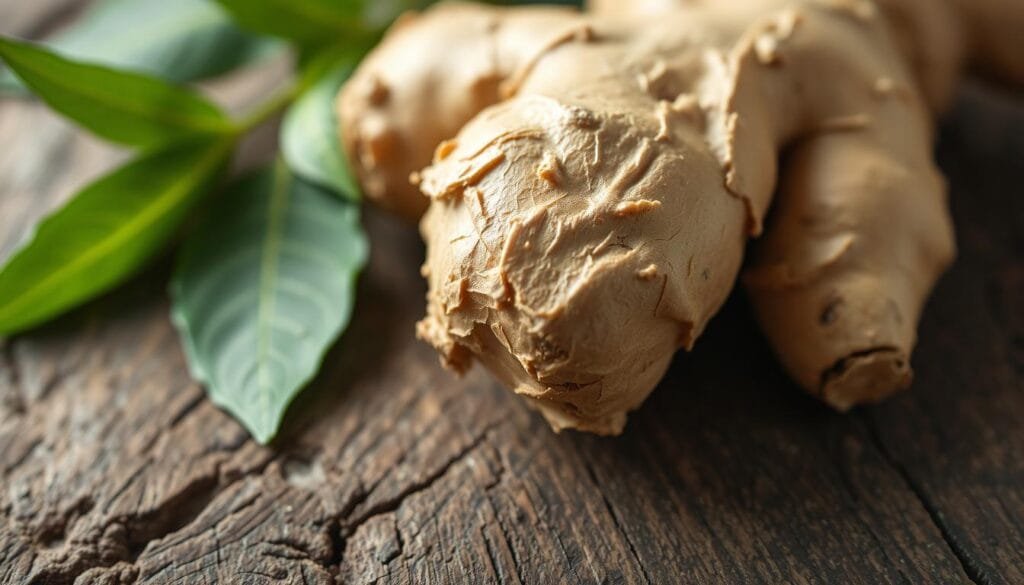I’m excited to share my guide on using herbal remedies for pain. We’ll look at many traditional herbs and natural options. They can help ease pain, reduce swelling, and improve overall health.
We’ll explore the pain-relieving powers of herbs like white willow bark, Boswellia, turmeric, ginger, and devil’s claw. You’ll see how these herbs work with your body to fight pain. They offer a safe way to manage pain from chronic conditions, joint issues, headaches, and more.
If you want to use fewer medicines or try alternative healing, this guide is for you. It will give you the knowledge to use herbal remedies for natural pain relief. Let’s explore the ancient secrets to better health and wellbeing together.
Understanding Pain and Inflammation in the Body
Chronic inflammation is often the root cause of many painful conditions. This includes arthritis, back pain, and tendonitis. It can also lead to serious health issues like cancer, cardiovascular disease, and diabetes. It’s important to understand how inflammation, the immune system, and pain management are connected. This knowledge helps find effective and natural solutions.
The Role of Chronic Inflammation in Pain
When the body gets injured or infected, the immune system starts an inflammatory response to heal. But sometimes, this response doesn’t stop, causing ongoing pain and health problems. Chronic inflammation is linked to many painful conditions, such as arthritis and back pain.
How Natural Remedies Work with Your Body
Natural remedies target the inflammation that causes pain. Herbs and plant-based compounds help regulate the immune system and reduce oxidative stress. They support the body’s natural healing. By addressing the root cause, these natural anti-inflammatories offer effective pain relief without the side effects of drugs.
The Connection Between Immune System and Pain
The immune system is key in feeling pain. When it’s activated by injury or infection, it can start an inflammatory process that causes long-term discomfort. Keeping the immune system balanced and strong is vital for managing chronic pain and overall health.
“A growing body of research suggests that a diet rich in anti-inflammatory herbs and spices may be associated with a diverse gut microbiome and reduced markers of inflammation and immune-related diseases.”
Traditional Herbs for Pain Relief: Ancient Wisdom Meets Modern Science
For centuries, traditional healing systems like Ayurveda and Traditional Chinese Medicine (TCM) have used herbs to ease pain. Now, modern science is proving these ancient remedies work.
Turmeric, a key part of Indian cuisine and Ayurvedic medicine, contains curcumin. This compound has been studied for its anti-inflammatory and antioxidant effects. Research shows curcumin can match the power of some prescription drugs in fighting inflammation and pain, like in arthritis.
Ginger, a versatile herb in traditional medicine, is known for its strong anti-inflammatory effects. The gingerols in ginger have been shown to lessen inflammation and pain in conditions like osteoarthritis and muscle soreness.
- Turmeric (Curcuma longa) contains curcumin, which has been extensively studied for its antioxidant and anti-inflammatory properties.
- Ginger (Zingiber officinale) is known for its potent anti-inflammatory properties, with active compounds (gingerols) shown to reduce inflammation and pain related to conditions like arthritis.
- Green tea (Camellia sinensis) is rich in catechins, antioxidants that help combat inflammation and can reduce inflammatory markers.
Traditional healing practices like acupuncture, Tui Na massage, and mind-body exercises like Tai Chi and Qigong have also been proven to fight inflammation and ease pain.
| Traditional Remedy | Modern Scientific Evidence |
|---|---|
| Acupuncture | Triggers the release of anti-inflammatory compounds and modulates the immune system |
| Tui Na Massage | Enhances circulation and supports the body’s natural healing processes |
| Tai Chi and Qigong | Effective in lowering inflammation levels, promoting immune function, and reducing stress |
As scientists keep studying traditional herbal remedies and mind-body practices, we’re seeing a blend of ancient wisdom and modern medicine. This is leading to more holistic and effective ways to manage pain.

White Willow Bark: Nature’s Aspirin Alternative
For centuries, people have used the white willow tree (Salix alba) for pain relief. Its bark has salicin, like aspirin. This makes white willow bark a natural anti-inflammatory.
Benefits and Active Compounds
White willow bark helps with knee, muscle, headache, and back pain. It also has polyphenols and flavonoids for extra anti-inflammatory effects. Some studies suggest it might even fight viruses and slow aging.
Recommended Usage and Dosage
- The usual dose for pain is 240 milligrams of white willow bark per day. It comes in capsules, creams, tinctures, and teas.
- Salicin levels in willow bark can vary a lot. Studies show it can be from 0.08% to 12.6% after 1-2 years.
- Find the right dose based on your needs and the product you’re using.
Potential Side Effects and Precautions
White willow bark is usually safe but can cause stomach issues, bleeding, and more serious problems. It’s not good for those allergic to aspirin or salicylates. Also, avoid it if you’re taking blood thinners, beta-blockers, or acetaminophen.
“The use of willow bark dates back to the time of Hippocrates in 400 BC, making it one of the oldest known natural remedies for pain relief.”
Boswellia: The Ancient Anti-Inflammatory Powerhouse
For centuries, the frankincense tree has been valued in Ayurvedic tradition. It’s known for its healing properties. One key compound is boswellia, a natural anti-inflammatory that helps with joint pain and wellness.
Boswellia comes from the Boswellia serrata tree found in India, North Africa, and the Middle East. It reduces inflammation and eases pain in osteoarthritis and rheumatoid arthritis. Its power comes from boswellic acids, which block the pro-inflammatory enzyme 5-lipoxygenase (5-LOX).
- The Arthritis Foundation suggests taking about 300–400 milligrams (mg) of boswellia three times a day.
- Research shows boswellia can lessen pain, swelling, and stiffness in joint conditions. Benefits start in 5 days and peak at 4 weeks.
- Boswellia may keep working even after you stop taking it, helping keep joint cartilage strong.
Boswellia’s benefits aren’t just for joints. It might also help with inflammatory bowel diseases, asthma, and some cancers. As we learn more, boswellia’s value for natural pain relief and health is clear.

While boswellia is usually safe, talk to a healthcare professional before using it. This is true if you’re on medications or have health issues. Boswellia’s long history and scientific support make it a powerful natural anti-inflammatory.
Turmeric and Curcumin: Golden Remedies for Pain Management
Turmeric, a bright yellow spice, is key in South Asian cooking. It’s known for its health benefits, thanks to curcumin. This compound is a strong anti-inflammatory and antioxidant.
Curcumin is great at managing pain and inflammation. It’s found in turmeric and is very effective.
How Curcumin Fights Pain
Curcumin fights pain by controlling inflammation. It stops the body from making inflammatory enzymes and proteins. This reduces pain and discomfort.
Research shows curcumin helps with osteoarthritis, rheumatoid arthritis, and autoimmune diseases. It’s also good for tendonitis and other muscle pains.
Ways to Enhance Turmeric Absorption
Turmeric’s bioavailability is low, meaning it’s hard for the body to use its active compounds. Mixing turmeric with black pepper boosts curcumin absorption by up to 2,000%.
Adding healthy fats like coconut oil or avocado to turmeric also helps. Curcumin is fat-soluble, so fats aid in its absorption.
Best Forms and Applications
You can use turmeric as a spice, supplement, or for topical pain relief. For better absorption, add it to dishes with healthy fats and black pepper.
For a stronger curcumin dose, consider high-quality supplements. But, talk to a doctor first. High doses can interact with some medicines, like blood thinners and chemotherapy.
Turmeric and curcumin offer a natural way to manage pain. They can be part of your diet or taken as supplements. This golden spice is a great way to support your health and well-being.
Ginger: A Versatile Pain-Fighting Root
Looking for natural pain relief? The humble ginger root is your answer. It’s been used for centuries to fight pain and inflammation. Ginger is packed with over 400 natural compounds, making it a powerful ally.
The compound [6]-gingerol in ginger is key to its anti-inflammatory power. Research shows ginger can match NSAIDs in reducing pain and swelling. This makes ginger a natural choice for pain relief.
Ginger helps with many pain issues. For example, it can ease knee and hip osteoarthritis pain. It also helps with menstrual cramps when taken in the right amounts.
Ginger is more than just a pain reliever. It’s full of vitamins, minerals, and terpenes. You can enjoy it fresh, as tea, or as a supplement. It’s a valuable tool in managing pain.
Ginger for Arthritis and Muscle Pain
Studies show ginger is great for arthritis and muscle pain. Its compounds, like [6]-gingerol, lower prostaglandin levels. This helps reduce pain and swelling in the body.
To get the most from ginger, add it to your daily routine. Use fresh ginger in meals, make tea, or take supplements. Choose what works best for you, based on your health and preferences.

Ginger is usually safe in small amounts. But, high doses can cause side effects. The FDA warns against more than 4-6 grams a day.
Always talk to your doctor before using ginger for pain. This is true if you’re on medications or have health issues.
Devil’s Claw: Relief for Arthritis and Back Pain
If you’re dealing with the tough effects of osteoarthritis or chronic lower back pain, there’s a natural help. It’s called Harpagophytum procumbens, or Devil’s Claw. This South African herb has been used for ages to ease joint and muscle pain. Modern science backs up its healing powers.
Scientific Evidence and Studies
Research shows Devil’s Claw can help with pain. A 2006 review found it works as well as some pain meds for back pain. A 1997 study showed it’s good for sudden back pain. Also, a 2006 review said it’s a good choice for osteoarthritis.
The herb’s active parts, like iridoid glycosides, help with pain and inflammation. They stop inflammatory chemicals, reduce stress, and balance the immune system. This makes it helpful for many people.
Proper Usage Guidelines
Devil’s Claw is sold in the U.S. as a supplement in many forms. There’s no set dose, but studies used 108 to 2400 mg daily for 8 to 12 weeks.
Before trying Devil’s Claw, talk to a doctor. It might affect some medicines and isn’t safe for everyone. Be careful if you’re allergic, pregnant, breastfeeding, or over 65.
| Potential Benefits | Possible Side Effects |
|---|---|
|
|
More research is needed, but Devil’s Claw looks promising for osteoarthritis and lower back pain. Always use it with care and under a doctor’s advice.

Essential Oils and Aromatherapy for Pain Management
Essential oils are gaining attention for natural pain relief. Lavender, peppermint, and eucalyptus oils are known for their pain-relieving properties. They work with the body’s systems to ease pain and improve well-being.
Lavender oil helps reduce pain during medical procedures. It calms and eases pain, from headaches to muscle aches. Peppermint oil may help with headaches and arthritic pain when applied to the skin. Eucalyptus oil is effective in reducing pain in rheumatoid arthritis patients when inhaled.
It’s important to use essential oils carefully, avoiding them around children. Always dilute the oils before skin application. If you have health concerns or are pregnant or nursing, consult a healthcare provider.
| Essential Oil | Pain-Relieving Properties | Key Benefits |
|---|---|---|
| Lavender | Reduces pain severity, calming and analgesic effects | Effective for headaches, muscle aches, and medical procedure-related pain |
| Peppermint | Topical pain relief for headaches and arthritis | Natural alternative to pain medication, fewer risks |
| Eucalyptus | Reduces pain in rheumatoid arthritis when inhaled | Anti-inflammatory and pain-relieving properties |
Remember, essential oils should be used with caution and under a healthcare professional’s guidance. Proper dilution and patch testing are key to avoid skin irritation or allergic reactions.
“Aromatherapy is more consistent for treating nociceptive (SMD = −1.57) and acute pain (SMD = −1.58) than inflammatory (SMD = −0.53) and chronic pain (SMD = −0.22).”
How to Combine Multiple Herbs for Pain Relief
Using herbal synergy for natural pain management can be amazing. Mixing certain herbs can boost their pain-relieving effects. But, it’s important to do it safely and avoid bad interactions.
Synergistic Herb Combinations
Some top herbal mixes for pain relief are:
- Turmeric and Ginger: They work together, boosting their anti-inflammatory powers.
- Willow Bark and Meadowsweet: Their salicylates offer a natural pain relief, like aspirin.
- Boswellia and Frankincense: These herbs have been used for ages to ease joint and muscle pain.
- Valerian, Vanilla, and Maple Syrup: This mix helps with pain and promotes relaxation.
Safety Considerations for Mixed Herbs
While mixing herbs can be effective, caution is key. Some herbs might not mix well with medicines or could cause problems. Always talk to a healthcare expert before mixing herbal remedies, if you have health issues or take medicines.
Also, make sure to choose high-quality herbs. Go for trusted brands and organic, eco-friendly options. This ensures the best and safest herbal synergy.
“The synergy of herbs can be truly powerful, but it’s essential to approach it with care and guidance from a qualified professional.”
Natural Pain Relief: When and How to Use Alternative Therapies
Looking for natural pain relief? Acupuncture, yoga, and mindfulness meditation can help. They work well with herbal remedies to manage pain.
Acupuncture is an ancient Chinese method. It treats many pains, like chronic pain and headaches. It targets body points to ease pain and aid healing.
Yoga is great for back pain and improving flexibility. Its stretches and deep breathing help relax muscles and boost movement. This is good for back pain sufferers.
Mindfulness meditation helps with chronic pain and improves life quality. It teaches being present and accepting. This helps manage pain better.
“Integrating alternative therapies like acupuncture, yoga, and mindfulness meditation can be a game-changer in your journey towards natural pain relief. These practices work in harmony with herbal remedies to provide a more holistic and effective solution for managing pain.”
Always talk to your doctor before trying new pain relief methods. With the right advice, you can find natural ways to manage pain and improve your health.
Safety Guidelines and Drug Interactions
Natural remedies can be helpful but also come with risks. Many herbs can affect how well medicines work or cause side effects. For example, white willow bark and ginger might make bleeding more likely.
It’s very important to talk to a healthcare provider before starting any herbal treatment. This is true if you have health issues or are taking medicines. Always stick to the recommended amounts and watch out for any allergic reactions.
Knowing about drug-herb interactions is key to using natural medicines safely. Natural medicine precautions are essential for safe use. Some herbs, like St. John’s Wort and Echinacea, can change how drugs are broken down in the body.
Ginkgo, for instance, can make blood clotting harder, which might increase the risk of bleeding. This is a problem if you’re taking medicines that prevent blood clots.
Doctors and herbalists must know about these interactions to help patients safely use herbs with medicines. Tools like the Natural Medicines Database and Medscape’s interaction checker are very helpful. By being open about your herbal use, you can work with your healthcare team to avoid risks and get the best treatment.







